
Wyoming high desert with red indian paintbrush, blue larkspur, and lots of yellow flowers (in foreground; click on image to view). But where's yermo?
I walked slowly, zig-zagging uphill, scanning the ground, checking everything yellow—yellow flax, yellow wild buckwheat, various DYCs (damn yellow composites). But no yermo. Had I missed it? Was my attention flagging in the heat and wind? “Go slow, look carefully” I said, and wandered back downslope but further north. Still nothing. Uphill again. Near the top I stopped ... and burst out laughing. There it was—spectacular! Yermo can't be overlooked.
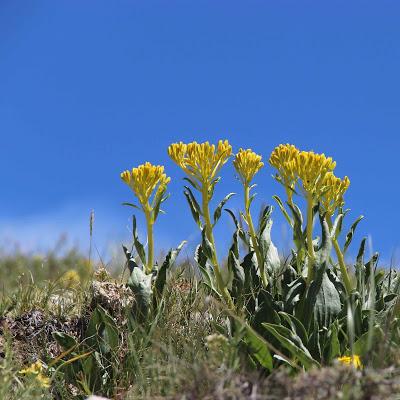
Yermo’s astonishing flamboyance.
Few Wyoming rare plants are as showy as yermo. It really stands out in the high desert setting, where aridity and wind favor low profile plants. Yermo is tall by local standards—up to a foot in height. The leaves are large, soft and fairly green, while most of its neighbors have dull tough drab little leaves, often covered in hair to keep precious moisture from evaporating.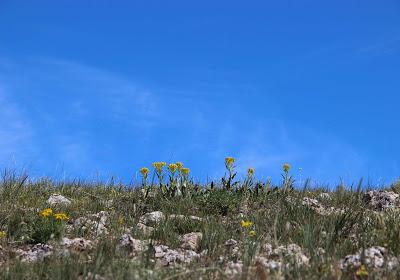
Yermo in the ‘hood.
Yermo isn’t totally without desert adaptations. Up close, one sees the leaves are leathery and look a bit waxy. It has a substantial taproot that surely helps during hard times.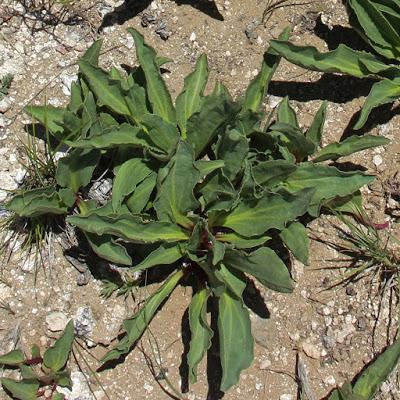
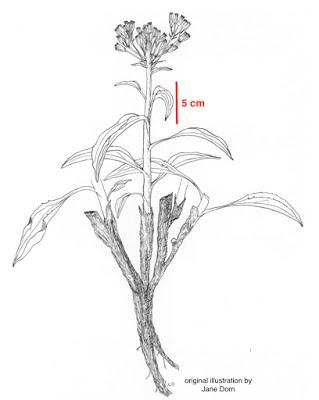
Yermo xanthocephalus, from the original description of the species (Dorn 1991).
In 1991, Bob Dorn, who knows the Wyoming flora well (he wrote Vascular Plants of Wyoming), was searching for a rare Phlox when he “encountered a very unusual plant”—as he wrote in his description of the new species (Dorn 1991). In fact, Yermo xanthocephalus wasn’t just a new species; it was unusual enough to be a new genus!Yermo translates to “wilderness” or “wasteland”—an uninhabited place; xanthocephalus means “yellow head.” Thus the official common name is desert yellowhead, but "yermo" is used just as often, if not more.
Yermo is a member of the sunflower or daisy family, the Asteraceae. Like all members, it has composite heads of flowers. In this case there are just 4-6 flowers per head.

Five heads with just a few flowers each (the two lower heads haven't opened yet).
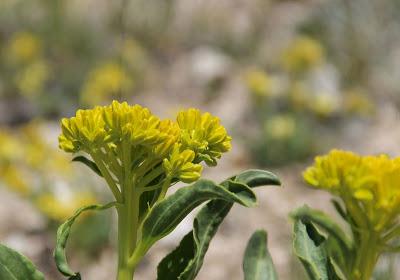
The distinctive keeled yellow bracts that enclose each small head are more obvious in bud.

Rosettes of leaves are young plants. Hopefully they'll produce flowering stalks in some future year.
There aren’t many yermo plants in the world. All of them grow in a tiny area of high desert, on the order of 35 square miles, in central Wyoming. For almost 20 years, botanists thought yermo was restricted to a single site. “We have searched far and wide for additional plants,” wrote Scott and Scott in 2009, “especially at sites with similar geological, geomorphological, and climatological characteristics, with no avail.” But then …In 2010, a new population was discovered, on an escarpment “that had been intensively surveyed for many miles” except for a gap of about a mile and a half (Heidel et al. 2011). Plants will do that—defy human analysis and prediction. They may be completely absent from what we’ve identified as potential habitat, and then when we’re about to give up, we find them where they "shouldn’t be!”
Yermo mid photo, growing where no one looked until 2010.
Prior to 2010, many botanists visited yermo, and carefully studied its habitat. It was described as level to gently-sloping sparsely-vegetated outwash at the base of eroded slopes. Plants were more dense in concave areas or depressions, possibly sites of snow accumulation. Compared with adjacent sagebrush areas, yermo soils were slightly finer, more alkaline, and less able to retain moisture.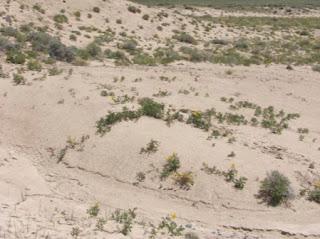
Original yermo site, where it grows on sparsely-vegetated outwash (click on image to view). WYNDD photo.
Everyone assumed yermo was an extreme habitat specialist. If there were more populations, they would be on similar sites. But yermo fooled the botanists. In 2010, it was found about five miles from the original population, not on sparsely-vegetated outwash but rather on the upper slopes of an escarpment, with bluebunch wheatgrass and junegrass, diverse forbs, and low shrubs. When I visited this site, I estimated vegetative cover to be 25-50%—not sparse. In addition, soil analysis has shown that the two sites differ significantly for at least 9 of 17 parameters measured (Heidel et al. 2011). Obviously we need to be more openminded.The original population contains on the order of 10,000 plants—with several areas of concentration, scattered plants in between, and outliers. The second population contains 400 plants, in seven small isolated patches. Do these represent dispersal events? Is yermo spreading and colonizing new habitat?
In addition to its unusual robustness and limited inconsistent distribution, yermo is odd in another way. Many of our rare plants are difficult to distinguish from their close relatives; the South Pass rockcress, which I wrote about recently, is a prime example. But not yermo. Not only is it easy to recognize, it looks like nothing else! We have few clues as to its close relatives; we can only speculate.Discoverer Bob Dorn considers yermo most closely related to several eastern North American species. He suggested it’s a relic of warmer wetter times when this part of Wyoming was forested—about 20 million years ago. That's when the sediments and ash that make up the rocks where yermo grows were deposited. With climate change—drying and cooling—forests retreated eastward, replaced by grassland and then desert. But it’s unlikely that yermo has been around that long. For one thing, diverse environments have intervened over the last 20 million years, including periglacial permafrost during Pleistocene times. Generally, there’s no reason to associate the age of a species with the age of the rock where it grows.Still, yermo may be a relic species, just more recent. Equally possible, given how little we know, it may be a truly “new” species—the product of recent catastrophic evolution. Plants can make evolutionary leaps, for example through hybridization or genome duplication (multiple times even!). The resulting new species may look quite different from the parents.Maybe when genome sequencing and analysis become really cheap, we can compare the full genomes of yermo and candidate relatives and figure all this out. I sure hope so! I would love to know yermo’s story. Why is it only here? Is it rare because it’s a holdover from a different time and environment? Or is it rare because it evolved recently and hasn’t had time to spread? Who are its parents? What’s its future? Will it persist, disperse seeds, and colonize new sites for botanists to find?
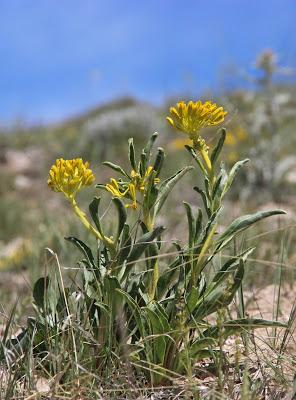
In 2002, Yermo xanthocephalus was listed as a Threatened species by the US Fish and Wildlife Service due to rarity and potential threats. Discovery of the second population in 2010 did not significantly change its status.
SourcesDorn, RD. 1991. Yermo xanthocephalus (Asteraceae: Senecioneae): A new genus and species from Wyoming. Madroño 38:198 – 201.Heidel, B., Fertig, W., Blomquist, F., and Abbott, T. 2008. Wyoming's Threatened and Endangered Species: Yermo xanthocephalus (desert yellowhead). Wyoming Bureau of Land Management, Cheyenne, WY. In collaboration with Wyoming Natural Diversity Database. PDFHeidel, B., Handley, J., and Andersen, M. 2011. Distribution and habitat requirements of Yermo xanthocephalus (desert yellowhead), Fremont County, Wyoming. Report prepared for the USDI Bureau of Land Management - Wyoming State Office by the Wyoming Natural Diversity Database - University of Wyoming, Laramie, WY. PDFScott, RW, and Scott, BJ. 2009. Yermo xanthocephalus Dorn, a research report. Prepared for Bureau of Land Management. Central Wyoming College Herbarium and Scott Environmental Resources, Inc. in cooperation with Wyoming Natural Diversity Database. Riverton, WY. PDF
